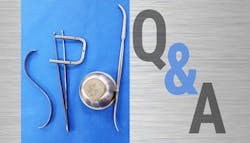BI testing, disinfection; reusable scrub caps; peel pouch weight limits; ceiling enclosures in SPD
Submit your questions: email: [email protected]
Q
Our healthcare system is in the process of building a large physician office building that will include a urology practice and a gynecology practice, which both will use a tabletop steam sterilizer and chemical disinfectants. I am not that familiar with the requirements for disinfection in the physician office setting and do not feel that the Centers for Disease Control and Prevention (CDC) guidelines provide any clear answer. Does the room where instruments are being disinfected need to be a negative pressure room? Does that room require 10 air exchanges per hour? What are the minimum standards for biological indicator (BI) testing on tabletop autoclaves?
A
The requirements for the disinfection process in a physician office or surgery center are no different than those of a hospital. Since you are part of a large healthcare system, I suggest that you contact the hospital sterile processing director for assistance relative to policies and procedures for sterilization and disinfection. All healthcare facilities within a healthcare system should maintain the same standard operating procedures (SOP). That means that any facility performing any of the sterile reprocessing functions (cleaning, disinfection and or sterilization) abide by the established system policies and procedures.
When developing procedures for the use and handing of chemical disinfectants, the user should consult the safety data sheet (SDS) supplied by the disinfectant manufacturer, to determine if any personnel or environmental hazards exist, and note the recommended safety precautions. In general, the following factors should be considered:
- Engineering controls, as required, such as adequate ventilation and/or a vented hood in the disinfection area to evacuate the chemical vapors
- The use of covered containers for the disinfectant solution, when appropriate
- Appropriate procedures and personal protective equipment (PPE) for the user, such as gloves, eye protection, surgical face masks, and liquid-resistant gowns or aprons, as required by Occupational Safety and Health Administration (OSHA) (29 CFR 1910.1030)
- Adequate rinsing of devices with sterile distilled water after disinfection
- Disposal of disinfectants
Regarding the air pressure to be maintained, it is recommended that the decontamination room where soiled medical devices are cleaned be a negative air pressure, and the preparation and sterilization room where cleaned items are inspected, assembled into kits, packaged and sterilized be a positive air pressure.
If the disinfection process is conducted in an area of the decontamination room, a clean workstation should be maintained for this function and personnel conducting the disinfection function should wear clean PPE.
The minimum standards for BI testing on tabletop autoclaves is the same as regular autoclaves, weekly preferably daily and with each load containing any implants..
Q
We are currently using disposable bouffant caps, not the scrubs caps that you tie in the back of your head, but we want to try out the reusable/washable caps. I have found ones that are made of same material as our scrubs (which we wash in-house), and we would do the same for the reusable caps. Does anyone use a reusable/washable cap?
A
I have not seen many facilities that are using reusable/washable caps as you have described. I heard from many that have experienced a high loss rate of reusable washable caps lost in transit, thrown away or not returned from the laundry. Thus, the anticipated cost savings was not actualized, as the cost of caps actually increased.
I have also seen hospitals that allow staff to wear personally-owned novelty caps that they are responsible for washing. They are required to wear a disposable bouffant cap over their novelty cap when in the work area.
Q
I’ve recently been asked if peel pouches have a weight limit. I’ve never heard of a weight limit for peel pouches, only for instrument trays (25 lbs.). Could you please clarify this statement?
A
Peel pouches are intended to be used on non-bulky items or a few items. The peel pouch manufacturer’s instructions for use (IFUs) that I have reviewed have not specified a weight restriction. More commonly, they provide guidelines on the distance the packaged item must have from all the internal pouch seams, and state that the thickness of the item should not cause tightness or tension on the package seams or closure. Fragile items or unprotected sharps should not be placed in a peel pouch. The specific pouch IFU must be consulted and adhered to.
Q
Our hospital’s very old sterile processing space is in the sub-basement and consists of four separate rooms. I need additional space for sterile storage, as the space that they are giving me is small (10’ X 112’) and has overhead pipes running through it. They are telling me there is no reason to enclose the pipes with a finished ceiling because they are going to be wrapped in a new insulated material. Will that replace the need for a ceiling?
A
A sterile storage area should be considered a restricted controlled area capable of providing and maintaining a clean environment for sterility maintenance. AAMI St79 3.3.5.3 states that ceilings in restricted areas should enclose pipes and duct work above clean work areas, including the sterile storage area. Ceiling areas must be constructed materials that are not made of particulate or fiber shredding materials. A finished ceiling with enclosed pipes and other fixtures will minimize dust, condensate and other sources of potential contamination.
About the Author

Ray Taurasi
Ray Taurasi is Principal, Healthcare CS Solutions. His healthcare career spans over five decades as an Administrator, Educator, Technologist and Consultant. He is a member of AORN, SGNA, AAMI and a past president of IAHCSMM. Taurasi has been a faculty member of numerous colleges teaching in the divisions of business administration, nursing, and health sciences. He is the author of numerous articles and textbook chapters; he is a frequent speaker at national and international healthcare conferences.
Note to readers from Ray Taurasi - In 2021, my life’s career path will transition to one of new opportunities and adventures. As a result, after nearly 19 years and 225 CS Solution columns, this edition will be my last.
“All changes, even the most longed for, have their melancholy; for what we leave behind us is a part of ourselves; we must die to one life before we can enter another.”– Anatole France
I wish you and your loved ones a healthy and joyful holiday season and a beautiful New Year! God Speed, Ray
https://www.facebook.com/pages/category/ Local-Business/Healthcare-CS-Solutions-128857 3061153887/ • email: [email protected]
